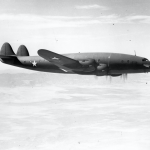by Bryan R. Swopes of This Day in Aviation
On January 27, 1939, First Lieutenant Benjamin Scovill Kelsey, Air Corps, United States Army, made the first flight of the prototype Lockheed XP-38 Lightning, serial number 37-457, at March Field, Riverside County, California. This was a short flight. Immediately after takeoff, Kelsey felt severe vibrations in the airframe. Three of four flap support rods had failed, leaving the flaps unusable. Returning to March Field, Kelsey landed at a very high speed with an 18° nose-up angle. The tail dragged on the runway. Damage was minor and the problem was quickly solved.
Designed by an engineering team led by Hall L. Hibbard, which included the legendary Clarence L. “Kelly” Johnson, the XP-38 was a single-place, twin-engine fighter designed for very high speed and long-range. It was an unusual configuration with the cockpit and armament in a center nacelle, with two longitudinal booms containing the engines and propellers, turbochargers, radiators, and coolers. The Lightning was equipped with the tricycle landing gear. The nose strut retracted into the center nacelle and the two main gear struts retracted into bays in the booms. To reduce drag, the sheet metal used butt joints with flush rivets.
The prototype had been built at Lockheed’s factory in Burbank, California. On the night of 31 December 1938/1 January 1939, it was transported to March Field aboard a convoy of three trucks. Once there, the components were assembled by Lockheed technicians working under tight security. The XP-38 was 37 feet, 10 inches (11.532 meters) long with a wingspan of 52 feet (15.850 meters) and an overall height of 12 feet, 10 inches (3.952 meters). Its empty weight was 11,507 pounds (5,219.5 kilograms). The gross weight was 13,904 pounds (6,306.75 kilograms) and the maximum takeoff weight was 15,416 pounds (6,992.6 kilograms).
The Lightning was the first production airplane to use the Harold Caminez-designed, liquid-cooled, supercharged, 1,710.60-cubic-inch-displacement (28.032 liters) Allison Engineering Company V-1710 single overhead cam 60° V-12 engines. When installed on the P-38, these engines rotated in opposite directions. The XP-38 used a pair of experimental C-series Allisons, with the port V-1710-C8 (V-1710-11) engine being a normal right-hand tractor configuration, while the starboard engine, the V-1710-C9 (V-1710-15), was a left-hand tractor. Through a 2:1 gear reduction, these engines drove the 11-foot (3.353 meters) diameter, three-bladed Curtiss Electric variable-pitch propellers inward to counteract the torque effect of the engines and propellers. (Viewed from the front of the airplane, the XP-38’s starboard propeller turned clockwise, the port propeller turned counter-clockwise. The direction of rotation was reversed in the YP-38 service test prototypes and production P-38 models.) The engines have long propeller gear drive sections to aid in streamlining aircraft, and are sometimes referred to as “long-nose Allisons.”
The V-1710-11 and -15 had a compression ratio of 6.65:1. They had a continuous power rating of 1,000 horsepower at 2,600 r.p.m. at Sea Level and 1,150 horsepower at 2,950 r.p.m. for takeoff. The combination of a gear-driven supercharger and an exhaust-driven General Electric B-1 turbosupercharger allowed these engines to maintain their rated power levels to an altitude of 25,000 feet (7,620 meters).
The -11 and -15 were 7 feet, 10.46 inches (2.399 meters) long. The -11 was 3 feet, 6.59 inches (1.082 meters) high and 2 feet, 4.93 inches (0.7348 meters) wide. It weighed 1,300 pounds (589.7 kilograms). The -15 was 3 feet, 4.71 inches (1.034 meters) high, 2 feet, 4.94 inches (0.7351 meters) wide, and weighed 1,305 pounds (591.9 kilograms).
The XP-38 had a maximum speed of 413 miles per hour (664.66 kilometers per hour) at 20,000 feet (6,096 meters) and a service ceiling of 38,000 feet (11,582.4 meters).
The XP-38 was unarmed, but almost all production Lightnings carried a 20 mm autocannon and four Browning .50-caliber machine guns grouped together in the nose. They could also carry bombs or rockets and jettisonable external fuel tanks.
The prototype XP-38 was damaged beyond repair when, on approach to Mitchel Field, New York, 11 February 1939, both engines failed to accelerate from idle due to carburetor icing. Unable to maintain altitude, Lieutenant Kelsey crash-landed on a golf course and was unhurt.
Testing continued with thirteen YP-38A pre-production aircraft and was quickly placed in full production. The P-38 Lightning was one of the most successful combat aircraft of World War II. By the end of the war, Lockheed had built 10,037 Lightnings.


































